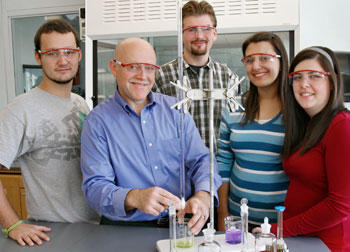Prof. Baures Receives Grant to Make Oil Pipelines Safer

Chemistry Professor and David F. Putnam Chair Paul Baures has been awarded a $65,000 grant from the American Chemical Society’s (ACS) Petroleum Research Fund (PRF) to conduct research on a significant problem that plagues the production of natural gas and oil.
Gas hydrates are flammable solids that contain naturally occurring gases inside an ice shell. They form wherever water and gas are present together in cold temperatures and high pressures, such as at the bottom of the ocean or in the arctic permafrost. They also form readily in oil pipelines during the production or transport of petroleum, where they greatly increase the danger to the oil workers and stymie production efforts.
The overall goal of this project is to identify a low cost, durable, and effective coating for petroleum transport or drilling pipes that prevents the formation of common gas hydrates. “Antifreeze proteins found in insects, fish, and plants help protect their cells from damage during cold temperatures by preventing ice from forming or by causing ice to form smaller crystals that do not harm cells,” Dr. Baures said. “Since we know that antifreeze inhibitors prevent gas hydrate formation, we hypothesize that we can incorporate features common to antifreeze proteins in nature to create a low-cost and durable coating on a glass substrate that can be used as a model of a hydrate-inhibiting coating inside pipes. If the ice can’t form, neither can the gas hydrates.”
The grant will support three years of research, and fund student researchers during the summer months. “These undergraduate researchers will synthesize and characterize the model coatings, as well as record our observations on their ability to inhibit or modify ice formation,” Dr. Baures explained. “Success in this project will be to identify a non-protein antifreeze coating that works on glass. This information would be an important first step in developing a similar coating for use inside drilling and transport pipelines.”
Gas hydrates are found in large quantities on the ocean floor and are estimated to contain twice the amount of carbon available in all the other fossil fuels on earth. Other scientists are therefore exploring how to effectively use this potent energy source. If you’d like to learn more, check out this video from the United States Geological Service (USGS) about their research. And see them light a chunk of ice on fire!





